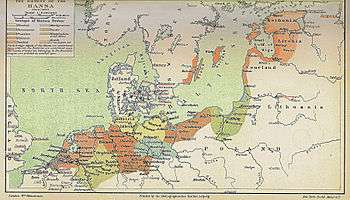Middle Low German
| Middle Low German | |
|---|---|
| Middle Saxon | |
| Region | Southern Baltic littoral, south-eastern North Sea littoral |
| Era | 12th to 15th centuries; evolved into Modern Low German and was gradually superseded by High German |
|
Indo-European
| |
Early form | |
| Dialects | |
| Latin (Fraktur) | |
| Language codes | |
| ISO 639-3 |
gml |
| Glottolog |
midd1318[1] |
| Linguasphere |
52-ACB-ca[2] |
 Northern Europe in 1400, showing the extent of the Hanseatic League | |

Middle Low German or Middle Saxon (ISO 639-3 code gml. In German: Mittelniederdeutsch) is a developmental stage of Low German. It developed from the Old Saxon language in the Middle Ages and has been documented in writing since about 1225/34 (Sachsenspiegel). The Middle Low German language was in the Hanseatic period from about 1300 to about 1600 the leading written language in the north of Central Europe and served as a lingua franca in the northern half of Europe. It was used parallel to medieval Latin also for purposes of diplomacy and for deeds.[3]
Related languages
Middle Low German is a term used with varying degrees of inclusivity. It is distinguished from Middle High German, spoken to the south, which was later replaced by Early New High German. It is sometimes taken to mean the dialect continuum of all the other high medieval Continental West Germanic dialects, from Flanders in the West to the eastern Baltic, but it is sometimes seen as separate from western varieties such as Middle Dutch.[4]
Middle Low German provided a large number of loanwords to languages spoken around the Baltic Sea as a result of the activities of Hanseatic traders. It is considered the largest single source of loanwords in Danish, Estonian, Latvian, Norwegian and Swedish.
History
Sub-periods of Middle Low German are:[5]
- Early Middle Low German (Modern Standard German: Frühmittelniederdeutsch): 1200–1370
- Classical Middle Low German (klassisches Mittelniederdeutsch): 1370–1530
- Late Middle Low German (Spätmittelniederdeutsch): 1530–1650
Middle Low German was the lingua franca of the Hanseatic League, spoken all around the North Sea and the Baltic Sea. It used to be thought that the language of Lübeck was dominant enough to become a normative standard (the so-called Lübecker Norm) for an emergent spoken and written standard, but more recent work has established that there is no evidence for this and that Middle Low German was non-standardised.[6]
Traces of the importance of Middle Low German can be seen by the many loanwords found in the Scandinavian, Finnic, and Baltic languages, as well as standard German and English.
In the late Middle Ages, Middle Low German lost its prestige to Early New High German, which was first used by elites as a written and, later, a spoken language. Reasons for this loss of prestige include the decline of the Hanseatic League, followed by political heteronomy of Northern Germany and the cultural predominance of Middle and Southern Germany during the Protestant Reformation and Luther's German translation of the Bible.
References
- ↑ Hammarström, Harald; Forkel, Robert; Haspelmath, Martin, eds. (2017). "Middle Low German". Glottolog 3.0. Jena, Germany: Max Planck Institute for the Science of Human History.
- ↑ "m" (PDF). The Linguasphere Register. p. 219. Retrieved 1 March 2013.
- ↑ Cordes, Gerhard; Möhn, Dieter (1983). Handbuch zur niederdeutschen Sprach- und Literaturwissenschaft. Erich Schmidt Verlag. p. 119. ISBN 3-503-01645-7.
- ↑ D. Nicholas, 2009. The Northern Lands: Germanic Europe, c. 1270–c.1500. Chichester: Wiley-Blackwell. pp. 180-98.
- ↑ Hilkert Weddige, Mittelhochdeutsch: Eine Einführung. 7th ed., 2007, p. 7
- ↑ Mähl, S. (2012). Low German texts from late medieval Sweden. In L. Elmevik and E. H. Jahr (eds), Contact between Low German and Scandinavian in the Late Middle Ages: 25 Years of Research, Acta Academiae Regiae Gustavi Adolphi, 121. Uppsala: Kungl. Gustav Adolfs Akademien för svensk folkkultur. 113–22 (at p. 118).
Sources
- Bible translations into German
- The Sachsenspiegel
- Reynke de Vos, a version of Reynard (at wikisource)
- Low German Incunable prints in Low German as catalogued in the Gesamtkatalog der Wiegendrucke, including the Low German Ship of Fools, Danse Macabre and the novel Paris und Vienne
External links
- A grammar and chrestomathy of Middle Low German by Heinrich August Lübben (1882) (in German), at the Internet Archive
- A grammar of Middle Low German (1914) by Agathe Lasch (in German), at the Internet Archive
- Schiller-Lübben: A Middle Low German to German dictionary by Schiller/Lübben (1875) at Mediaevum.de and at the Internet Archive
- Project TITUS, including texts in Middle Low German
- A Middle Low German to German dictionary by Gerhard Köbler (2010)
- Middle Low German influence on the Scandinavian languages